Some of the links in this post may be affiliate links.
Thrips are arguably the most frustrating and persistent houseplant pest that you will encounter. I know the struggle all too well, so in this post, I will cover everything that you need to know about how you can practically and effectively deal with thrips on houseplants.
I’ll touch on the lifecycle of thrips, which is really important to understand so that you can effectively treat for them. This is not a pest that you can spray once and be done with it. This goes for many pests, but particularly thrips.
I also have some photos showing thrips damage so that it can help you correctly identify the problem. I’ll also recommend some products that I like to use to manage and eliminate thrips on houseplants.
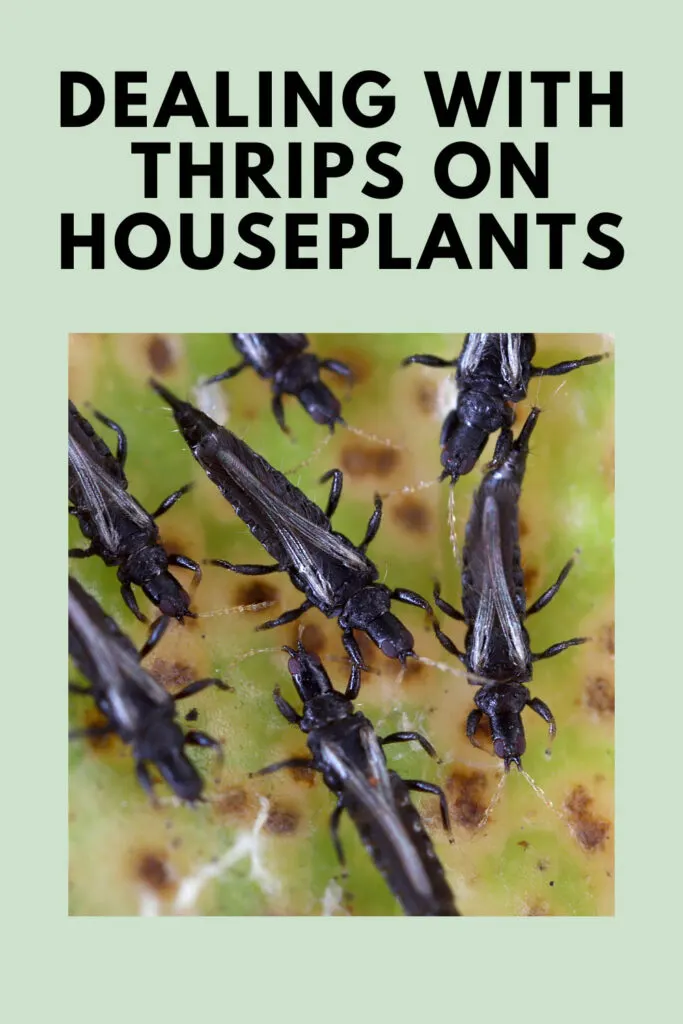
I’ve learned that all it takes is ONE female thrips in order to cause a big infestation in your houseplants. There are about 6,000 species of thrips, and many will devastate commercial crops, but only about a dozen or so appear on our houseplants.
Also, before we continue, I’d like to mention that the singular and plural is…thrips. One thrips and two thrips are both correct…but in the end, we want ZERO thrips, so let’s get into it.
Table of Contents
WHAT ARE THRIPS?
Thrips are very small pests and often times, you will see the damage that they cause before you actually notice the pests themselves. Most thrips are only about 1mm long or so and are very narrow.
Most of the adult thrips that I’ve seen are black in color, but they can also be other colors as well. Immature thrips, called nymphs, will be lighter in color.
Here is a closeup of an adult thrips:
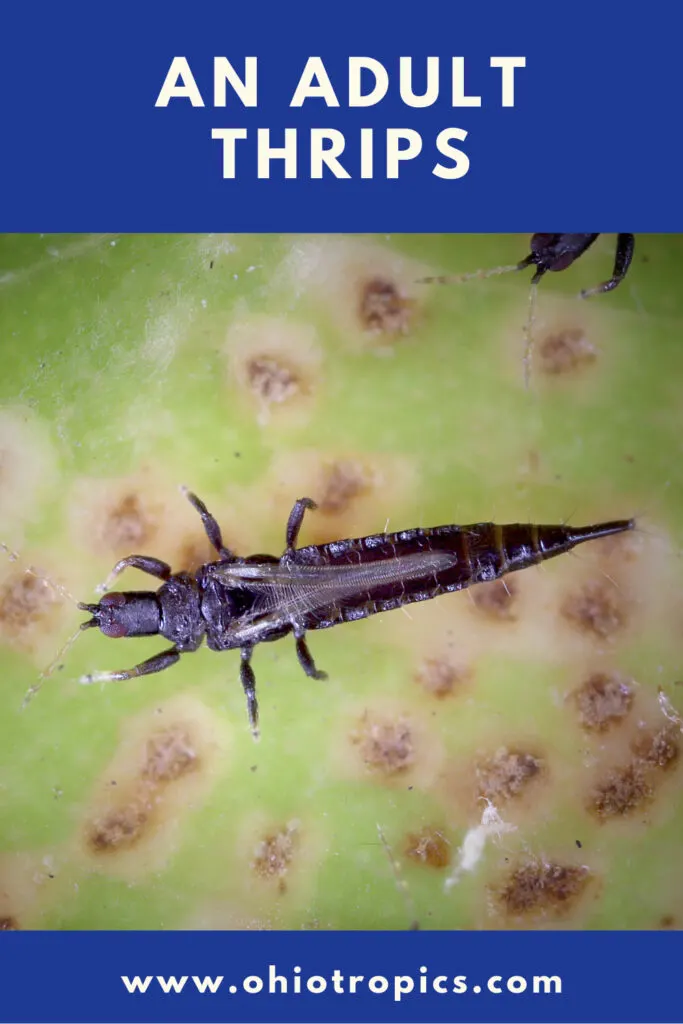
Here are some nymphs that I found scattered all over on my Peperomia polybotrya, or Raindrop Peperomia. Note the pale color:
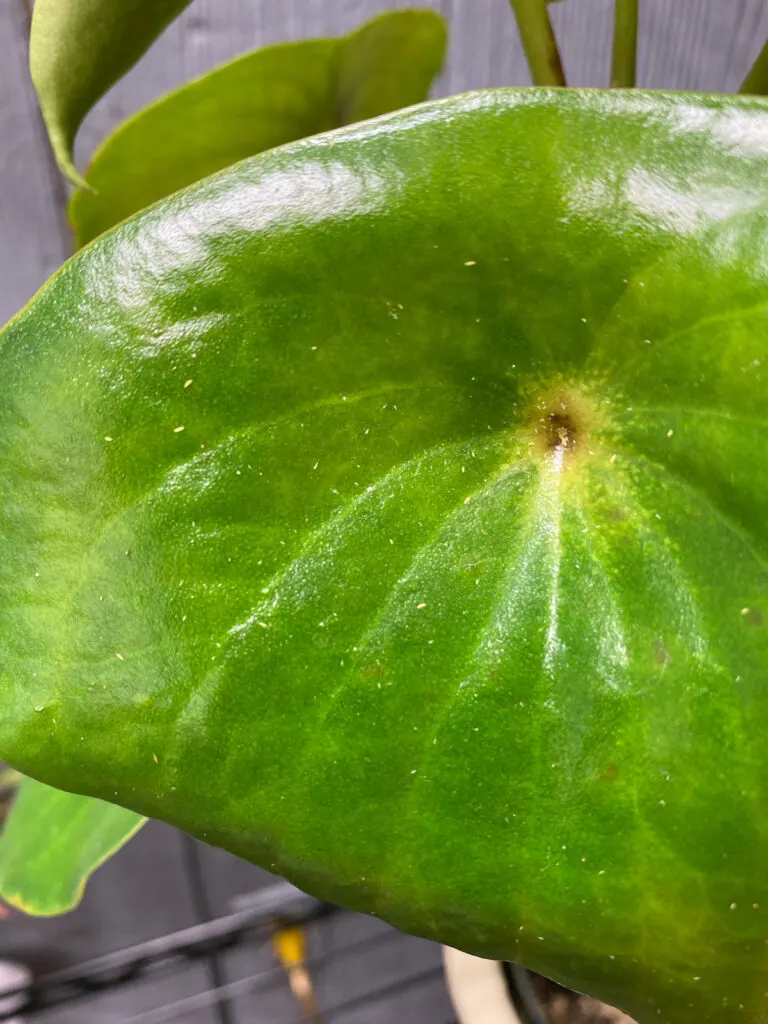
THRIPS DAMAGE ON HOUSEPLANTS
How do thrips damage your plant?
Thrips basically pierce holes into your plants (leaves, flowers, etc.), and then they literally suck out your plant’s sap and juices.
The resulting damage will typically look like silvery or brownish marks on your foliage. Some species of thrips even leave dark deposits (which is basically thrips poop!) Gross.
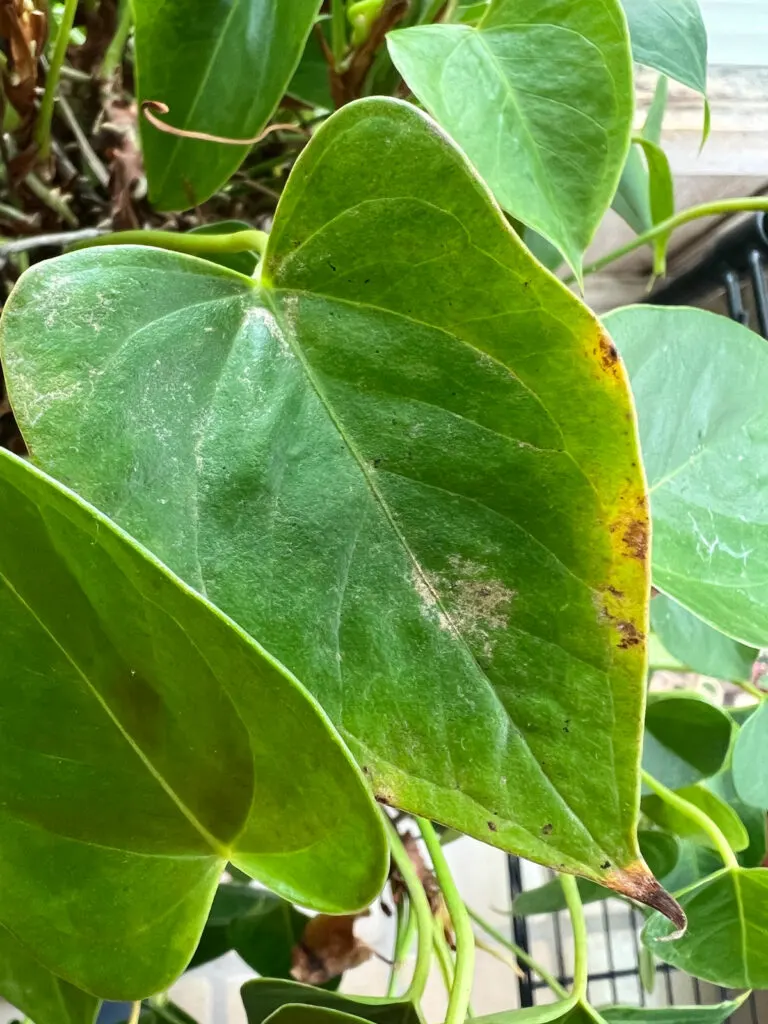
Be sure to also inspect the bottom of your leaves as well. In the photo below, the top of the Anthurium leaf looked fine, but take a look at the thrips damage at the bottom.
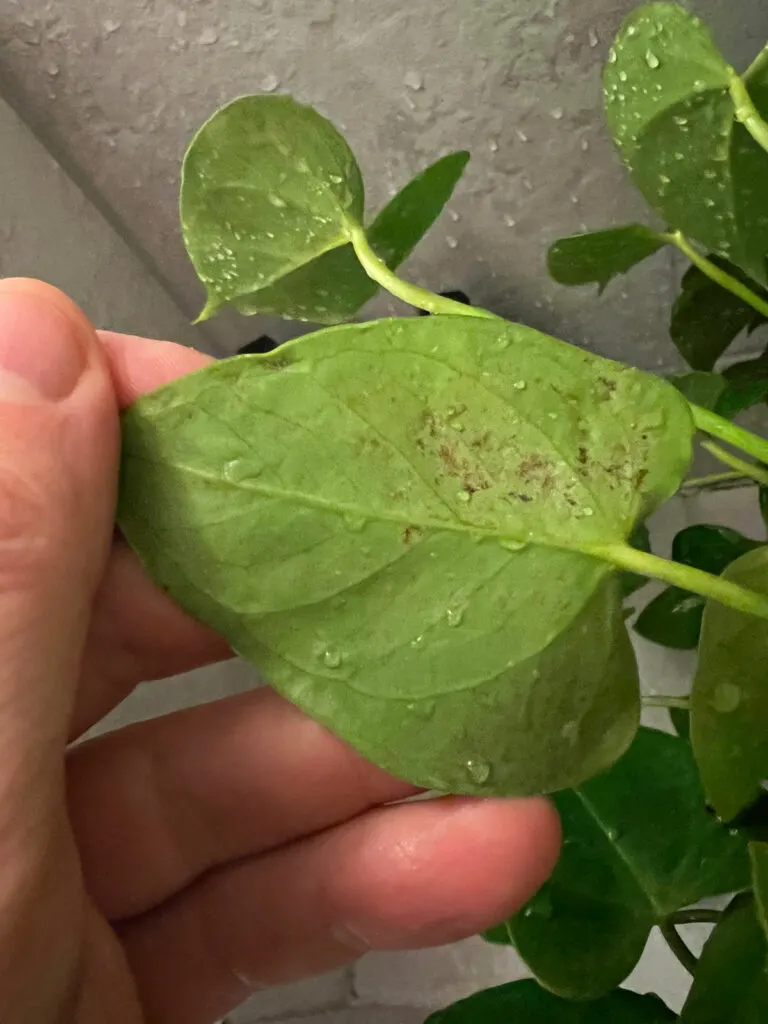
Flowers and leaves can even develop silvery streaks, and the new growth or growing points of your plants can seem gnarly and contorted.
Here is some thrips damage on an Oxalis triangularis leaf.
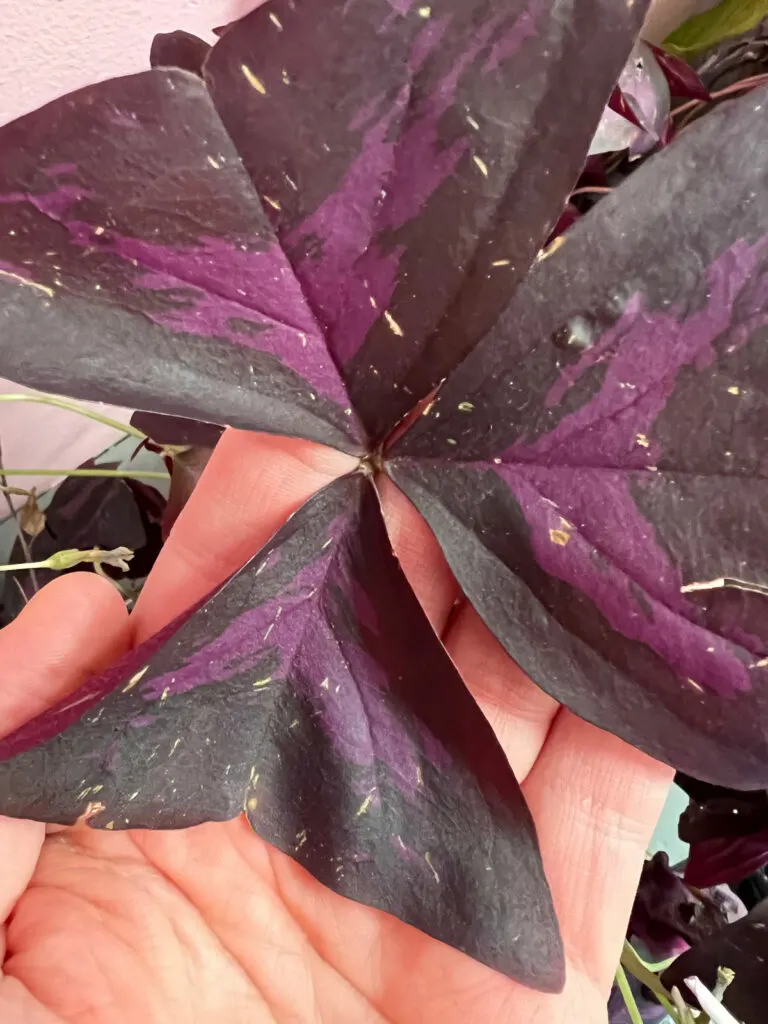
Female thrips will insert their eggs into your plant’s foliage, flowers and stems. Then the eggs will hatch and the juvenile thrips, called nymphs, start feeding on your plant.
In most species of thrips, the fully grown nymphs will often drop to the soil where they will undergo the pupal stage. After this part of the lifecycle, they will then transform into adults and fly back up to your plant and perpetuate a cycle of destruction.
Under the right temperatures and conditions thrips can go from eggs to adult in as soon as 2 weeks.
One of the reasons that thrips are so difficult to manage, is that even if you use an insecticide spray on your plant, it will kill any nymphs and adults, but the eggs will not be affected since they are buried in your plant’s tissue.
Read this post in its entirety because I will discuss the best ways to treat thrips on houseplants so that you can enjoy the most success.
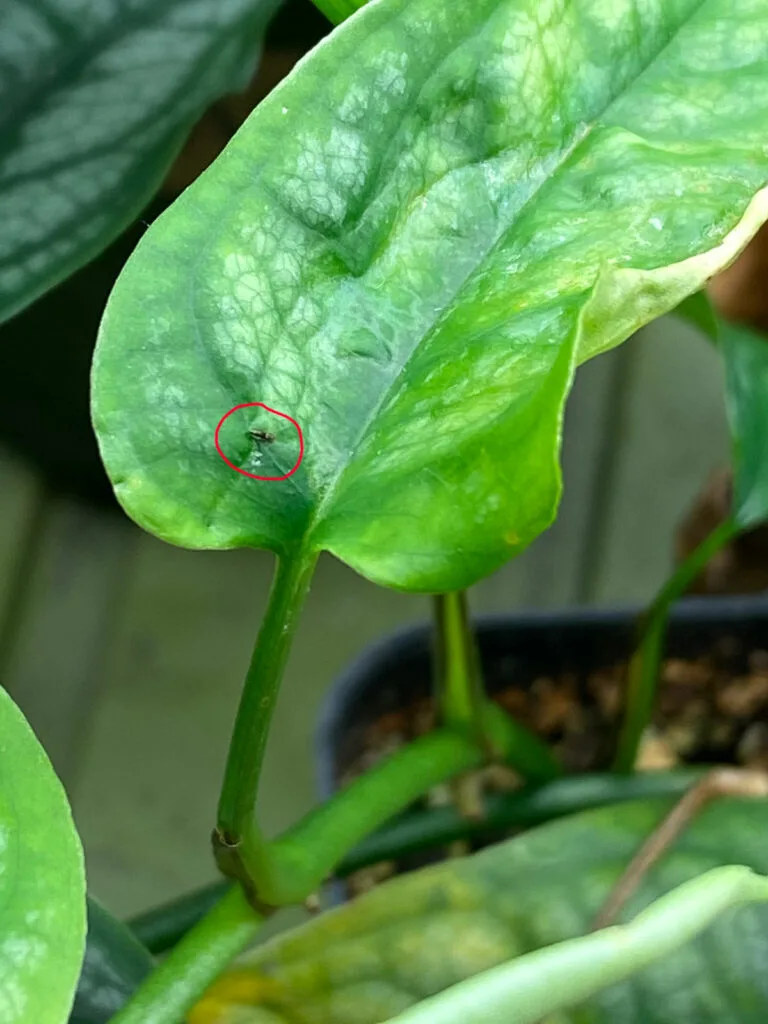
WHERE DO THRIPS COME FROM INDOORS?
Thrips can come from a number of places including:
- If you’ve summered your plant outdoors, they could have attacked your plant and you could have proceeded to bring thrips indoors when you’ve brought your plant back inside.
- Thrips could have been lurking on new houseplants that you’ve purchased or brought home. They are often very difficult to see, especially at the beginning of the infestation.
- Among the most susceptible houseplants to thrips are: Aroids (Monstera, Alocasia, ZZ Plant, and many more), palms and Calathea.
HOW TO GET RID OF THRIPS ON HOUSEPLANTS
For plants that have suffered a severe infestation, it may be best to just throw away the plant. Unless it’s something rare or special to you, often times, it is not worth fighting the battle if the plant is severely infested.
Please note that some plants can be sensitive to
If you are using
Keep your plants out of direct sun when you spray them while the plant is still wet.
If you’ve noticed that the leaves had an adverse effect, try another spray. Always read the label carefully as they will often list which plants the product is not safe for.
Here is the process that I use to treat for thrips:
1. Remove heavily infested leaves/flowers
Cut off or trim away any heavily infested plant parts. Place them in the trash, tie the bag up tightly and discard.
2. Wash down your plant
Take your plant to a sink or shower, or even outdoors if you’d like if it’s warm enough. Rinse off your entire plant as thoroughly as you can, including the undersides of the leaves.
This will help knock down the population of thrips on your foliage.
3. Spray with insecticidal soap
Next, after the plant is dry, I like to use a good
If you have any flowers that seem affected be sure to spray those as well (or just snip them off and throw them away).
The
Bonide makes a good insecticidal soap that you can use. Insecticidal soaps are considered to be non-toxic to humans and pets.
4. Apply a systemic insecticide
Like I mentioned earlier in this post, any type of insecticide spray that you apply will not work on the thrips eggs because they are found under the surface of the leaf inside of the plant’s tissue.
This is where a systemic insecticide comes in. You can sprinkle the recommended amount of systemic insecticide into your soil and water it in.
The plant will then take up the insecticide from the roots. When thrips feed on your plant, it will essentially poison them and thus help stop the lifecycle from perpetuating.
I use Bonide Systemic Houseplant Insect Control for this purpose. Use only as directed on the label and apply at the recommended frequency.
This is available for home use in the U.S., but apparently is not available in some countries like Canada and others.
Using a systemic insecticide in combination with diligent spraying with
If you don’t want to use a systemic or can’t obtain any, you can still treat with
5. Use sticky traps to capture adult thrips
You may already be very familiar with yellow sticky traps used to capture adult fungus gnats. They will also work on thrips!
Place your yellow sticky traps in the pot of your infested plants and monitor them as they catch your thrips.
Blue sticky traps are particularly attractive to thrips, so you can use these as well. You can even use them in combination with yellow sticky traps. Place a yellow stick trap at the base of your plant near the soil, and maybe hang a blue sticky trap right above your plant.
Capturing as many as you can on the sticky traps will help knock down the population since they will no longer be able to lay eggs on your plants.
6. Repeat steps 2 and 3 weekly
Don’t skip this step! This one is critical! It is important to repeat step 2 (washing down your plant) and step 3 (spraying with
Try and be diligent and do this weekly because there are always thrips in different stages of their lifecycle, so this is necessary to kill as many thrips as possible.
Lastly, there is one practice that I wanted to mention that I’ve heard many plant parents do. Some people will wash off all the soil from the roots and repot into fresh potting mix.
I would recommend not taking this approach for the following reasons:
- You can still have thrips dropping from the foliage above into your fresh soil, thus negating the reason you changed the soil out in the first place. This was stated by Keele University professor of entomology William Kirk, who also added that thrips sometimes pupate on the plant, but usually it’s on the soil or surface of the soil.
- Removing all of the soil from your plant will also unnecessarily shock your houseplant. Stressed plants will be even more prone to further pest attacks.
PRODUCT LIST
To summarize, here are the products I recommend:
- Bonide Insecticidal Soap
- Yellow sticky traps
- Blue sticky traps
- Bonide Systemic Houseplant Insect Control
PREVENTING THRIPS
What are some things that you can do to prevent thrips from attacking your houseplant collection?
- Give your plants weekly or biweekly showers if you can. This will not only knock off any thrips that happen to be on your plants, but it will also keep your plants free of dust and allow them to be healthier.
- Inspect any new plants that you are purchasing very closely and avoid bringing home any potentially infested plants.
- When you do bring any new plants home, it is a good idea to quarantine the plant for 2-3 weeks if you can. Place your new plant away from other plants while you monitor.
- Increase humidity preferably with a good humidifier. Thrips (as well as spider mites) tend to prefer drier air, so providing a more humid environment will help to deter them.
- Inspect your plants regularly! It is much easier to treat a pest issue when caught early.
RELATED CONTENT
If you’ve enjoyed this content on treating thrips on houseplants, check out my other blog posts on dealing with other pests on your houseplants:
Lastly, if you’d like to hear more details about thrips (from entomology professor William Kirk) check out Jane Perrone’s excellent podcast (On the Ledge) episode where she interviews professor Kirk talking about thrips.
FREQUENTLY ASKED QUESTIONS
Will my plant recover from thrips?
Any plant parts that have already been affected will not return to normal. However, with proper treatment, you can monitor the new growth to ensure that your plant is thrips-free.
Do thrips spread to other plants?
Yes, they definitely can. Some plants tend to be more prone to thrips than others though. Aroids (like Monstera species), and Calathea species seem to be attractive to thrips.
Where do thrips lay eggs?
Most thrips will lay their eggs just below leaf surfaces. This makes it tricky to treat, but if you wash down your plant and apply insecticidal soap weekly with diligence for several weeks, and use a good systemic insecticide in the soil, you can effectively treat thrips. Also be sure to use sticky traps to capture adult thrips.
Do thrips like wet or dry soil?
Thrips and spider mites like hot and dry environments. If you can maintain high humidity and fairly moist soil, this can help to deter thrips.
Have you had thrips on your houseplants? I’d love to hear your struggles and how you’ve overcome them. Comment below!

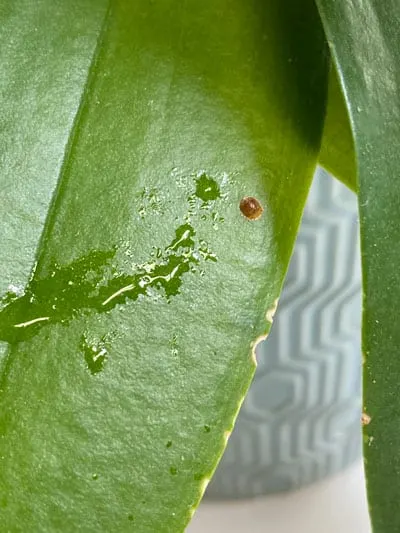
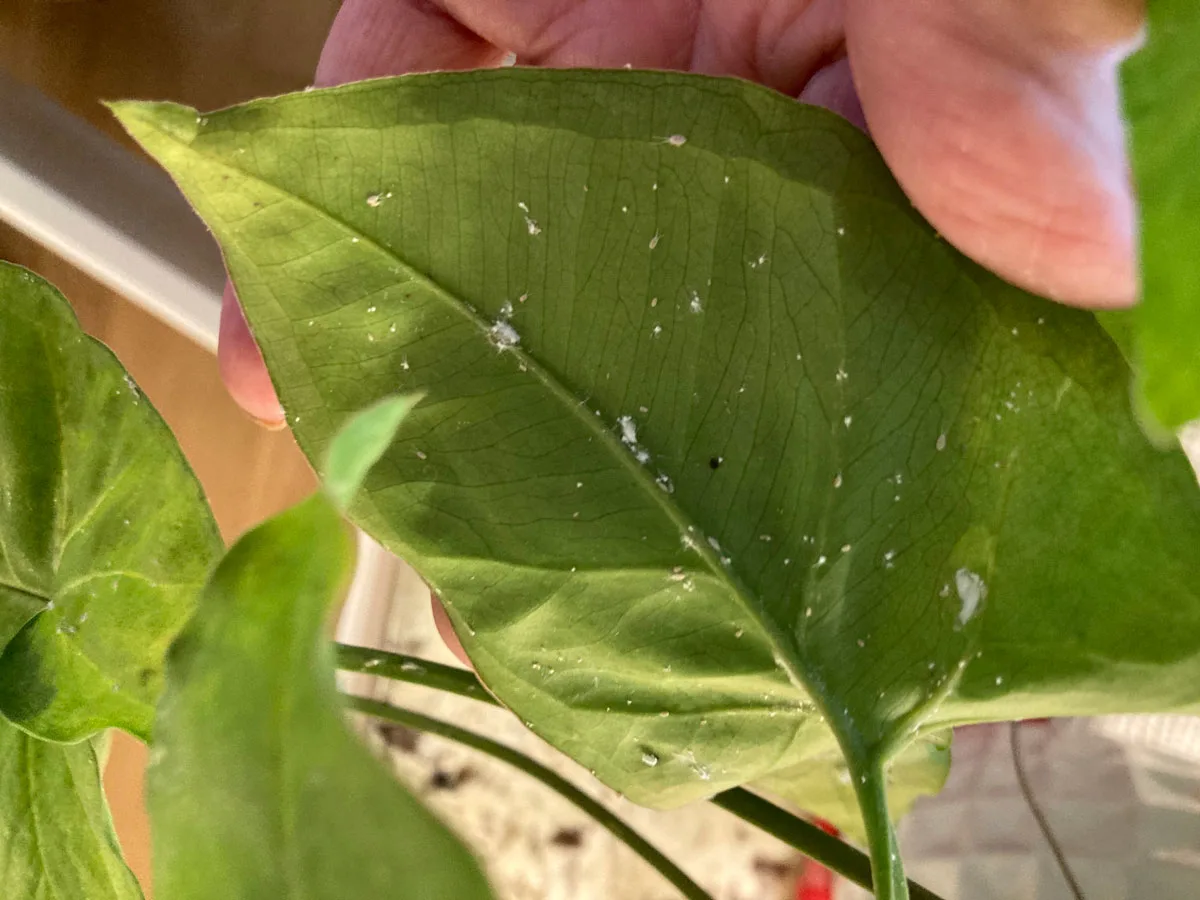
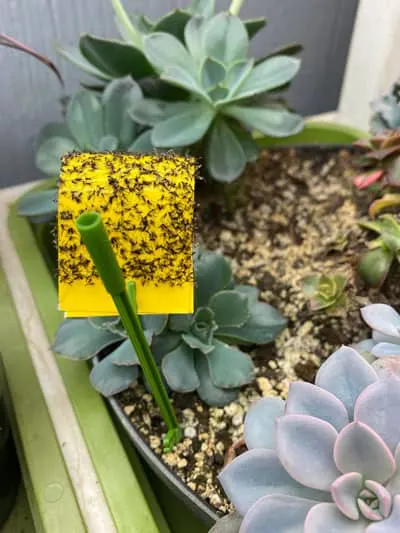
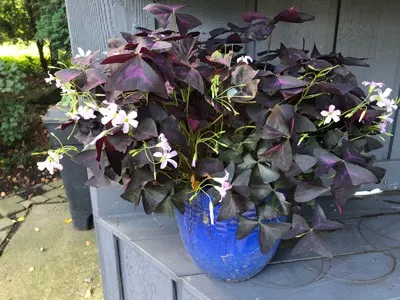
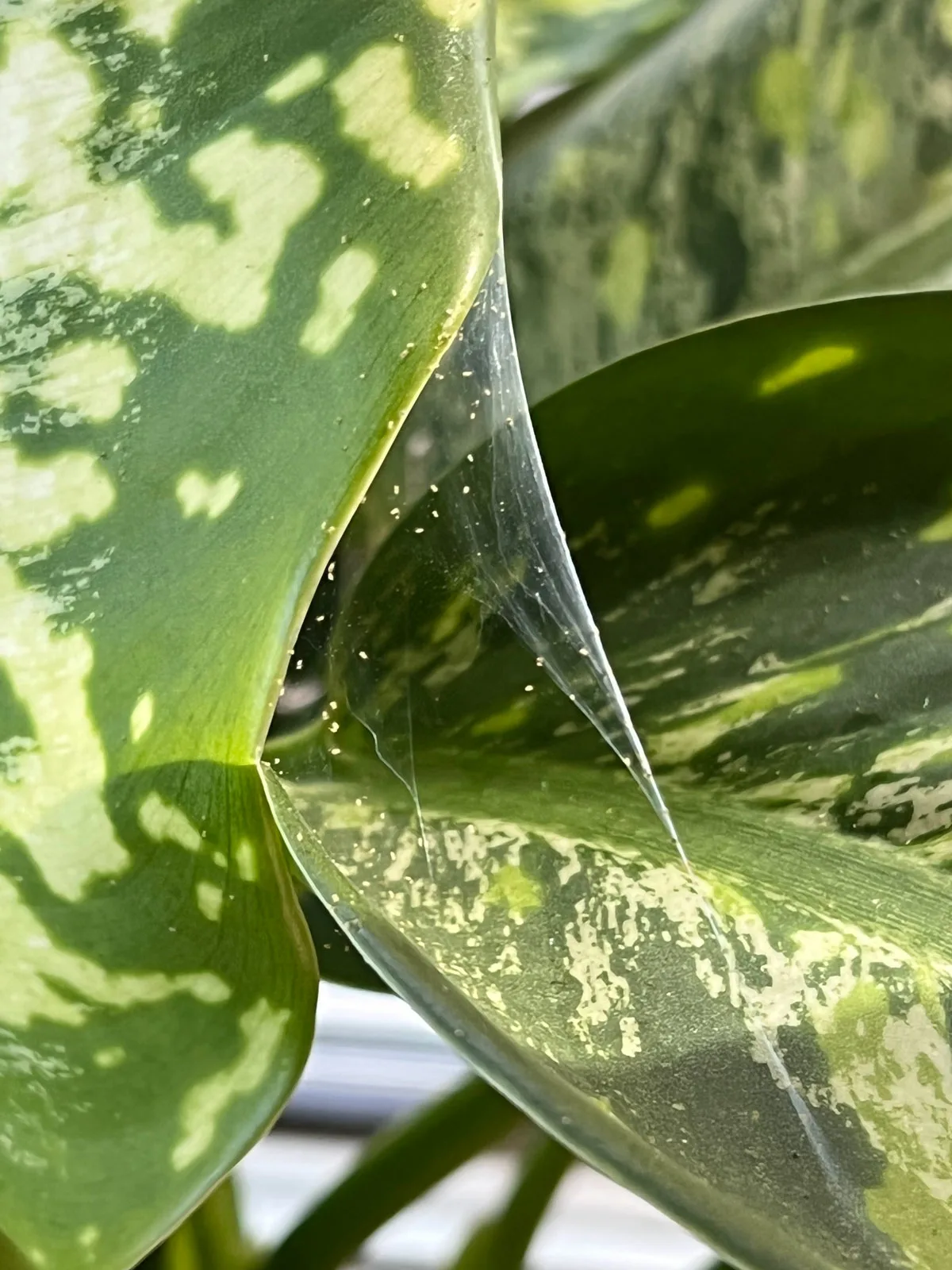

Sue
Thursday 4th of December 2025
This information about thrips was very helpful, especially the photos. I've had a thrips problem now for one year. I did all that you recommended last spring, plus placed every houseplant on a rack in my bathtub for 2 months while treating with insecticide and diatomaceous earth. We thought we won, but this fall they came back with a vengeance.
The key piece of information I want to share is that the thrips infestation I now have is almost completely occurring in covered terrariums. 75-95% humidity. Too many articles say they don't like humidity, but my experience says that's flat out wrong. I've since taken two large plant terrariums out of the house and tossed every single plant in the garbage (not compost). I suspect we will never be thrips free again unless we do a 100% removal of houseplants. It's heartbreaking. We got the thrips from a tiny fern we picked up at a plant store last winter. I regret that $5 purchase every day.
Raffaele Di Lallo
Friday 5th of December 2025
Thrips can be really challenging unfortunately :-( Thanks for sharing your experiences Sue.
Paulina
Saturday 30th of December 2023
Thank you very much for article. Do you know what can I use istead this Bonide product because I'm not living in US I live in Nederlands.
Raffaele
Sunday 31st of December 2023
Hi Paulina. I would go to a garden center and ask for any systemic insecticide that they may sell where you are. There may be something similar, but I know that this type of product isn't able to be sold in every country.
Patience
Friday 9th of June 2023
Thank you so much for this article. This is my first time dealing with thrips and I'm honestly freaking out. I'm going to try what you recommended but would u recommend just throwing the plant out? If they're that difficult to get rid of then I worry about thinking they're gone and then more plants getting them. Also, I've only seen 1 adult thrip in the last few weeks but my plants keep getting these black circles that look somewhat shiny?? I used images of them to figure out it was thrips, but I just don't see many adults. Any advice?
Raffaele
Sunday 11th of June 2023
Throwing the plant out is sometimes the best solution so that you're not spreading the thrips....thrips can be very difficult to get rid of and can spread very quickly!
Danielle Mahanes
Wednesday 29th of March 2023
I have been fighting thrips in my little greenhouse since September 2022. I have tried everything that you mentioned as well as many other things such as neem oil pyrethrins Spanosid acephate hydrogen peroxide mineral oil wiping down with alcohol just about everything but beneficial insects. It doesn’t matter what time of day or night. If I see the one I am out there trying to kill it before I can sleep. I finally decided to call my extension office here in Charleston where I live I was told by the officer that I should just throw all my plants away, I could always just get new ones. This was heartbreaking to me as I’m sure most plant people would understand the connection. We have two are plants especially individuals we’ve had for a long time all right, that was brought through rough time for many reasons that for me I was a garden designer and landscaper here in Charleston for 20 years ago, cancerous tumor, and became paralyzed and had to close my business my only connection to my former life due to the fact that I lost everything throwing them away is so painful I just keep hoping there is something I can do some hell thank you so much for this and for listening to what I have to say
Raffaele
Wednesday 29th of March 2023
Hi Danielle, I'm so sorry to hear of these struggles. I hope you are healthy now, and thrips are definitely a giant pain...if you're very persistent, you can manage them, but you have to be vigilant and treat your plants regularly. Good luck! I know the struggle!
Christie
Saturday 26th of November 2022
Hello! And thanks so much for this detailed article about treating thrips! I have been battling thrips for about 2 years now (on and off) with varying degrees of success. Some of my plants I chose to trash and some I chose to treat. For many weeks in a row, I was using a combination of Insecticidal Soap and Captain Jack's Deadbug Brew. Those have worked pretty well for most of my mildly infested plants, but others . . . well, the bugs just would not stop reappearing--they are very good at keeping their species alive!! Recently, I switched to Diotomaceous Earth (DE), sprinkled on top of the potting soil or below the pot inside the decorative container. Left it there for many weeks and bottom-watered so as not to rinse it out. So far, I think this approach has given me the most control over the pesky thrips. Now, a few weeks after I removed the DE from the top of the soil, or let it rinse away with waterings, they are coming back again (!##!). So, I guess I will need to just leave the DE in place indefinitely. But after reading your article, I will try using the systemic granules (in combination with Insecticidal Soap, like you recommend).
Oh, me. It can be discouraging, having to treat bugs for so long, but I think once you get thrips, it'll probably be an ongoing battle. But, maybe it's worth it, with all that we get from our plants.
Thanks for the great articles!!
Raffaele
Sunday 27th of November 2022
So glad you enjoyed the post Christie! And I'm sorry you're dealing with thrips. They are NOT fun to deal with! Keep up with it, and you can successfully manage them! Best of luck! (And it is ok to throw plants away if they are severely infested. Sometimes it's just not worth trying to remedy.).